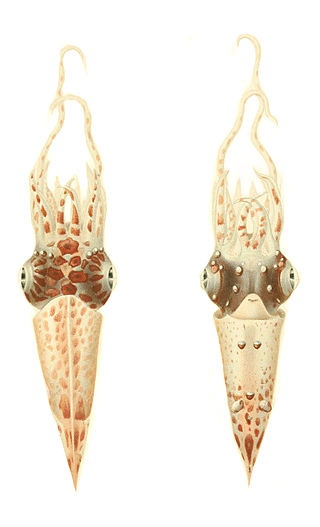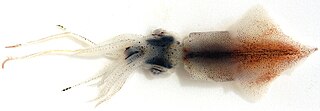
The Enoploteuthidea are a family of squid comprising approximately 40 species in four genera. Most species have a mantle length ranging from 3–13 cm (1.2–5.1 in). Hooks are present on all arms and tentacles. The family is best known for the large array of photophores throughout the body.

Ommastrephidae is a family of squid containing three subfamilies, 11 genera, and over 20 species. They are widely distributed globally and are extensively fished for food. One species, Todarodes pacificus, comprised around half of the world's cephalopod catch annually.

Liocranchia is a genus of glass squid from the family Cranchiidae. They are moderate-sized with a long, spindle-shaped mantle which tapers to a point at the rear and they can attain mantle lengths of 250 millimeters (9.8 in). The species in Liocranchia have a cosmopolitan distribution in tropical and subtropical oceans although it has been suggested that on especies, Liocranchia reinhardti is associated with land masses. In seas off Hawaii waters, L. reinhardti undergoes vertical migrations while L. valdiviae occurs in deep water and is sedentary. They are eaten by many oceanic predator species.

Onykia robusta, also known as the robust clubhook squid and often cited by the older name Moroteuthis robusta, is a species of squid in the family Onychoteuthidae. Reaching a mantle length of 2 m (6.6 ft), it is the largest member of its family and one of the largest of all cephalopods. The tentacular clubs are slender, containing 15–18 club hooks. Arms of the species contain 50–60 suckers, and grow to 90–100% of the mantle length. It is found primarily in the boreal to Temperate Northern Pacific.

Onychoteuthis banksii, the common clubhook squid, is a species of squid in the family Onychoteuthidae. It is the type species of the genus Onychoteuthis. This species was thought to have a worldwide distribution but with the revision of the genus Onychoteuthis in 2010, it is now accepted that Onychoteuthis banksii is restricted to the central and northern Atlantic and the Gulf of Mexico while a recently described species, Onychoteuthis horstkottei, is found in the Pacific Ocean. The type locality is the Gulf of Guinea.

Magnoteuthis microlucens is a species of squid; the most common species of Mastigoteuthis around the main Hawaiian Islands.

Onychoteuthis compacta is a species of squid in the family Onychoteuthidae, known to occur in Hawaiian waters. as well as in other areas of the Central Pacific and western north-central Atlantic, it probably has a circumglobar distribution. The species is known to have a mantle length of at least 122 mm for females and 127 mm for males. Each tentacle has 22 club hooks, measuring approximately 30 mm in mature specimens.

Pyroteuthis is a genus of squid in the family Pyroteuthidae. It is differentiated from the genus Pterygioteuthis by size, head shape and behaviour. Species within the genus are separated by the arrangement of tentacular photophores; the shape of the hectocotylus, and the shape of the hectocotylus hooks. With the exception of the Tropical Eastern Pacific, the genus is circumpolar in tropical and temperate oceans. The species P. addolux is the only member to occur in the North Pacific.

Pterygioteuthis is a genus of squid in the family Pyroteuthidae. Members are differentiated from the genus Pyroteuthis due to size and head shape. The genus is characterised by the presence of a lidded photophore over each eye.

Pterygioteuthis microlampas is a species of squid in the family Pyroteuthidae. They occur from northern New Zealand oceans to the Hawaiian Islands, but they do not overlap with the species P. gemmata, which lives in more southern waters. While there are numerous similarities between these two species, they are separated by the smaller mature size of P. microlampas and the fewer number of hooks on males. The species reproduce sexually during the late autumn to early winter, producing eggs with a diameter of 0.9 mm.
Pyroteuthis margaritifera, the jewel enope squid, is a species of squid in the family Pyroteuthidae.
Pyroteuthis serrata is a species of squid in the family Pyroteuthidae. It is found north of the tropical convergence in the waters around New Zealand and it does not overlap with Pyroteuthis margaritifera which has a more southerly range.

Pterygioteuthis gemmata is a species of squid in the family Pyroteuthidae.

Pterygioteuthis giardi is a species of squid in the family Pyroteuthidae. It is known as the roundear enope squid. The specific name honors the French zoologist and marine biologist Alfred Mathieu Giard (1846-1908).
Pyroteuthis addolux is a species of squid in the family Pyroteuthidae. It is distinguished from other members of the genus Pyroteuthis by the shape of photophores on the tentacles and the shape of the hectocotylus. The hectocotylus is located on arm IV, containing 10 proximity hooks, and six to 15 suckers at the tip. P. addolux ranges from south of the Hawaiian Islands, to the subantarctic boundary. They exhibit minor geographical variance, as southern specimens are slightly smaller than their northern counterparts. P. addolux is the only member of the genus to occur in the North Pacific, but additional members of the family Pyroteuthidae have also been found. The species has been observed using bioluminescence to reduce its silhouette in dim surrounding light. The type specimen was taken off southern California and described in 1972 by Richard E. Young.

Illex coindetii, commonly known as the southern shortfin squid or broadtail shortfin squid, is a species of neritic squids in the family Ommastrephidae. They are found in the Mediterranean Sea and on both sides of the north Atlantic Ocean.

Taonius belone is a glass squid belonging to the genus Taonius from the family Cranchiidae. It occurs in the northern subtropical and in the tropical or equatorial waters of the Pacific Ocean and the Indian Ocean.
Richard E. Young is a teuthologist. He is an Emeritus Professor of Oceanography at the University of Hawaii's School of Ocean and Earth Science and Technology.
Pterygioteuthis hoylei is a species of squid in the family Pyroteuthidae. It is considered conspecific with Pterygioteuthis giardi by some authorities. It can be identified from P. giardi by having four photophores on the tentacles and many chromatophores spread along the tentacle stalk and around the aboral surface of the tentacular club. It is also slightly larger than P. giardi, it has been so far recorded only from the eastern tropical Pacific Ocean where it is the only species of in the family Pyroteuthidae to occur there, although its actual distribution may be wider than currently known. The specific name honours the British malacologist William Evans Hoyle (1855-1926).

Enoploteuthoidea is a superfamily of squid in the order Oegopsida.














